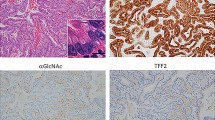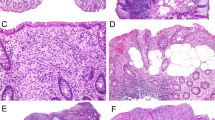Abstract
The colorectal adenoma-carcinoma sequence was examined in relation to the ectopic expression of the oncofoetal Small Intestinal Mucin Antigen (SIMA), to the development of morphologic changes in the adenoma and perineoplastic mucosa and to indices of malignant potential. Four anti-SIMA MAbs, which define a novel hierarchy of SIMA epitopes in the normal small intestine and adjacent to colorectal cancers, were used in a retrospective immunohistochemical study of Familial Adenomatous Polyposis (FAP, n = 183) and non-familial (n = 44) adenomas. Inappropriate expression of SIMA epitopes was first detected in mucosa adjacent to minute microadenomas larger than three glands, and with increase in size, in increasing amounts within adenomas themselves, but not with microadenomas smaller than three glands or regions of flat mucosa free of adenomas. SIMA epitope expressed in mucosa adjacent to adenomas preceded changes in perineoplastic morphology, which progressed with adenoma growth to resemble transitional mucosa (TM) adjacent to cancers. Thus, the onset of both SIMA expression and morphological changes in TM were consistent with reactive rather than pre-existing field change phenomena. The previously reported hierarchy of four SIMA epitopes (5C5, 3D4, 4D3, 6C5) was also consistently observed in the adenoma-carcinoma sequence, and applied to (i) the order of epitope detection, (ii) the number of positive adenomas and (iii) extent of staining; (iv) the height in the crypt and (v) distance from the adenoma to which epitopes were expressed in perineoplastic mucosa. These observations are consistent with a progression of changes in mucin composition with adenoma development. The percentage of positive adenomas and reactivity scores for each anti-SIMA MAb correlated with increasing adenoma size, degree of dysplasia and growth pattern. SIMA expression appears to predate the earliest reported oncogene and tumour suppressor gene changes, was persistent and increased throughout adenoma development. SIMA epitopes are thus markers of very early neoplastic change, whose expression correlates with malignant potential and may contribute to the accumulation of changes necessary for tumourigenesis.
This is a preview of subscription content, access via your institution
Access options
Subscribe to this journal
Receive 24 print issues and online access
$259.00 per year
only $10.79 per issue
Buy this article
- Purchase on Springer Link
- Instant access to full article PDF
Prices may be subject to local taxes which are calculated during checkout
Similar content being viewed by others

Author information
Authors and Affiliations
Rights and permissions
About this article
Cite this article
Pilbrow, S., Hertzog, P. & Linnane, A. The adenoma-carcinoma sequence in the colorectum – early appearance of a hierarchy of small intestinal mucin antigen (SIMA) epitopes and correlation with malignant potential. Br J Cancer 66, 748–757 (1992). https://doi.org/10.1038/bjc.1992.351
Issue Date:
DOI: https://doi.org/10.1038/bjc.1992.351


